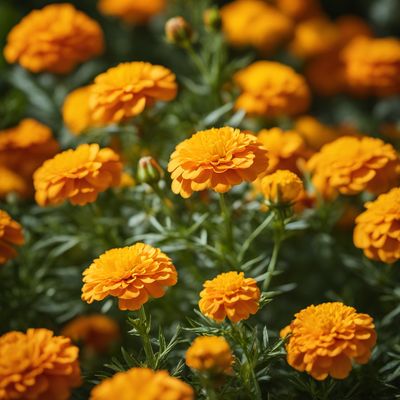
Ingredient
Dwarf marigold
The Vibrant Delight: Dwarf Marigold
Dwarf marigold, scientifically known as Tagetes patula, is a small flowering plant that belongs to the sunflower family. It is characterized by its compact size and vibrant flowers, which come in shades of yellow, orange, and red. Dwarf marigold flowers have a velvety texture and a distinct citrusy aroma. When used in cooking, they impart a subtle peppery taste with hints of citrus. These flowers are prized for their ornamental value and are often used to garnish salads, soups, or desserts.
Origins and history
Dwarf marigold is native to Mexico and Central America and has a rich cultural history. It was highly revered by the Aztecs, who considered it a sacred plant with powerful medicinal properties. The flowers were used in religious ceremonies, as well as for their culinary and cosmetic benefits. Today, dwarf marigold is widely cultivated for its vibrant flowers and is a popular choice for adding color and flavor to various dishes.
Nutritional information
Dwarf marigold flowers are low in calories and fat. They are a good source of antioxidants, including carotenoids, which give them their vibrant colors. These flowers also contain compounds that have antimicrobial and anti-inflammatory properties. Incorporating dwarf marigold flowers into your diet can add a burst of color and flavor while providing potential health benefits.
Allergens
None known
How to select
When selecting dwarf marigold flowers, look for fresh, vibrant blooms that are free from blemishes or signs of wilting. Avoid flowers that appear discolored or have damaged petals. Opt for organically grown flowers whenever possible to ensure they are free from pesticides or other harmful chemicals.
Storage recommendations
To maintain the freshness and quality of dwarf marigold flowers, store them in an airtight container in the refrigerator. Proper storage will help preserve their vibrant colors and aroma for an extended period. Avoid exposing the flowers to moisture, as this can cause them to wilt or develop mold.
How to produce
Dwarf marigold can be easily grown from seeds. It thrives in well-draining soil and prefers full sun. Sow the seeds directly in the garden or start them indoors and transplant them once they have developed a few leaves. Regular watering and deadheading (removing spent flowers) will encourage continuous blooming. Harvest the flowers when they are fully open and at their peak freshness.
Preparation tips
Dwarf marigold flowers can be used in a variety of culinary applications. They are often used as a garnish for salads, soups, or desserts, adding a pop of color and a subtle peppery taste. These flowers can also be infused into oils or vinegars to create flavorful dressings or marinades. Additionally, they can be used to make herbal teas or incorporated into homemade potpourri for their aromatic properties.
Availability
Dwarf marigold is widely cultivated and can be found in various regions around the world. It is commonly grown in gardens, both for its ornamental value and culinary uses. Additionally, it is commercially cultivated for the production of natural dyes and essential oils.

